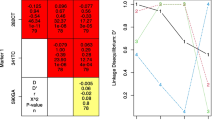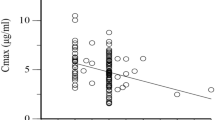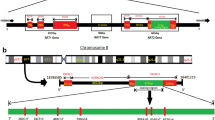Abstract
Arylamine N-acetyltransferase 2 (NAT2) metabolizes isoniazid (INH) and Single Nucleotide Polymorphisms (SNP) responsible for its activity has been reported. The aim of this study in the Mexican mestizo population was to evaluate NAT2 expression at the protein level in immune cells, as well as the distribution and frequency of six NAT2 SNPs and their association with anti-TB therapy, by measuring the plasma levels of INH and Acetyl-INH (AcINH). We performed genotyping assays of NAT2 SNPs in 40 TB patients and 121 healthy volunteers by real-time PCR. A method for detecting NAT2 in immune cells using flow cytometry was developed. Plasma concentrations of INH and AcINH were obtained by HPLC in TB patients and the Metabolic Ratio (MR) was calculated. The phenotypes obtained in the healthy volunteers were as follows; 18.87 % of subjects had the rapid acetylator phenotype, 45.45 % had the intermediate phenotype and 39.66 % exhibited the slow acetylator phenotype. In the TB patient group, 35 % of patients had the rapid acetylator phenotype, 32.5 % were intermediate and 32.5 % showed the slow acetylator phenotype. A higher expression level of NAT2 in innate immune cells from TB patients compared to those from healthy volunteers was detected (P < 0.013). In TB patients the MR showed a bimodal distribution with an antimode of 0.7, which was used as a threshold value for acetylator classification. A high correspondence between the rapid and slow acetylator phenotype with MR was demonstrated. In conclusion, the 282C>T, 341T>C, 481C>T, 590G>A, 803A>G, 857G>A SNPs of NAT2 gene provides accurate for prediction of the acetylator phenotype in Mexican mestizo population. A statistical difference was found in frequency of rapid metabolizer phenotype, which was higher in TB patients. In addition, the expression of NAT2 protein in immune cells can lead to further studies related to its functional role in the innate immune response against M. tuberculosis and other xenobiotics metabolized by this enzyme.





Similar content being viewed by others
References
Sim E, Walters K, Boukouvala S (2008) Arylamine N-acetyltransferases: from structure to function. Drug Metab Rev 40(3):479–510
Walraven JM, Zang Y, Trent JO, Hein DW (2008) Structure/function evaluations of single nucleotide polymorphisms in human N-acetyltransferase 2. Curr Drug Metab 9(6):471–486
Sim E, Lack N, Wang CJ, Long H, Westwood I, Fullam E, Kawamura A (2008) Arylamine N-acetyltransferases: structural and functional implications of polymorphisms. Toxicology 254(3):170–183
Grant DM, Goodfellow GH, Sugamori K, Durette K (2000) Pharmacogenetics of the human arylamine N-acetyltransferases. Pharmacology 61(3):204–211
Boukouvala S, Fakis G (2005) Arylamine N-acetyltransferases: what we learn from genes and genomes. Drug Metab Rev 37(3):511–564
Cascorbi I, Brockmoller J, Mrozikiewicz PM, Muller A, Roots I (1999) Arylamine N-acetyltransferase activity in man. Drug Metab Rev 31(2):489–502
Rodrigues-Lima F, Dairou J, Dupret JM (2008) Effect of environmental substances on the activity of arylamine N-acetyltransferases. Curr Drug Metab 9(6):505–509
McIlleron H, Wash P, Burger A, Norman J, Folb PI, Smith P (2006) Determinants of rifampin, isoniazid, pyrazinamide, and ethambutol pharmacokinetics in a cohort of tuberculosis patients. Antimicrob Agents Chemother 50(4):1170–1177
Cai Y, Yi J, Zhou C, Shen X (2012) Pharmacogenetic study of drug-metabolising enzyme polymorphisms on the risk of anti-tuberculosis drug-induced liver injury: a meta-analysis. PLoS One 7(10):e47769
Holdiness MR (1984) Clinical pharmacokinetics of the antituberculosis drugs. Clin Pharmacokinet 9(6):511–544
Hein DW (2009) N-acetyltransferase SNPs: emerging concepts serve as a paradigm for understanding complexities of personalized medicine. Expert Opin Drug Metab Toxicol 5(4):353–366
Harris HW, Knight RA, Selin MJ (1958) Comparison of isoniazid concentrations in the blood of people of Japanese and European descent; therapeutic and genetic implications. Am Rev Tuberc 78(6):944–948
Sime E, Hickman D (1991) Polymorphism in human N-acetyltransferase–the case of the missing allele. Trends Pharmacol Sci 12(6):211–213
Garcia-Martin E (2008) Interethnic and intraethnic variability of NAT2 single nucleotide polymorphisms. Curr Drug Metab 9(6):487–497
Salazar-Flores J, Dondiego-Aldape R, Rubi-Castellanos R, Anaya-Palafox M, Nuno-Arana I, Canseco-Avila LM, Flores-Flores G, Morales-Vallejo ME, Barojas-Perez N, Munoz-Valle JF, Campos-Gutierrez R, Rangel-Villalobos H (2010) Population structure and paternal admixture landscape on present-day Mexican-Mestizos revealed by Y-STR haplotypes. Am J Hum Biol 22(3):401–409
Lisker R, Ramirez E, Babinsky V (1996) Genetic structure of autochthonous populations of Meso-America: Mexico. Hum Biol 68(3):395–404
Kinzig-Schippers M, Tomalik-Scharte D, Jetter A, Scheidel B, Jakob V, Rodamer M, Cascorbi I, Doroshyenko O, Sorgel F, Fuhr U (2005) Should we use N-acetyltransferase type 2 genotyping to personalize isoniazid doses? Antimicrob Agents Chemother 49(5):1733–1738
Wagner CR, Bergstrom CP, Koning KR, Hanna PE (1996) Arylamine N-acetyltransferases. Expression in Escherichia coli, purification, and substrate specificities of recombinant hamster monomorphic and polymorphic isozymes. Drug Metab Dispos Biol Fate Chem 24(2):245–253
Stephens M, Smith NJ, Donnelly P (2001) A new statistical method for haplotype reconstruction from population data. Am J Hum Genet 68(4):978–989
Stephens M, Scheet P (2005) Accounting for decay of linkage disequilibrium in haplotype inference and missing-data imputation. Am J Hum Genet 76(3):449–462
Au WW, Sierra-Torres CH, Cajas-Salazar N, Salama SA (1999) Inheritance of polymorphic metabolizing genes on environmental disease and quality of life. Mutat Res 428(1–2):131–140
Wilkinson GR (2005) Drug metabolism and variability among patients in drug response. N Engl J Med 352(21):2211–2221
Chamorro JG, Castagnino JP, Musella RM, Nogueras M, Aranda FM, Frias A, Visca M, Aidar O, Peres S, de Larranaga GF (2013) Sex, ethnicity, and slow acetylator profile are the major causes of hepatotoxicity induced by antituberculosis drugs. J Gastroenterol Hepatol 28(2):323–328
Hein DW, Doll MA (2012) Accuracy of various human NAT2 SNP genotyping panels to infer rapid, intermediate and slow acetylator phenotypes. Pharmacogenomics 13(1):31–41
Bell DA, Taylor JA, Butler MA, Stephens EA, Wiest J, Brubaker LH, Kadlubar FF, Lucier GW (1993) Genotype/phenotype discordance for human arylamine N-acetyltransferase (NAT2) reveals a new slow-acetylator allele common in African-Americans. Carcinogenesis 14(8):1689–1692
Cascorbi I, Drakoulis N, Brockmoller J, Maurer A, Sperling K, Roots I (1995) Arylamine N-acetyltransferase (NAT2) mutations and their allelic linkage in unrelated Caucasian individuals: correlation with phenotypic activity. Am J Hum Genet 57(3):581–592
Mrozikiewicz PM, Cascorbi I, Brockmoller J, Roots I (1996) Determination and allelic allocation of seven nucleotide transitions within the arylamine N-acetyltransferase gene in the Polish population. Clin Pharmacol Ther 59(4):376–382
Agundez JA, Olivera M, Martinez C, Ladero JM, Benitez J (1996) Identification and prevalence study of 17 allelic variants of the human NAT2 gene in a white population. Pharmacogenetics 6(5):423–428
Gross M, Kruisselbrink T, Anderson K, Lang N, McGovern P, Delongchamp R, Kadlubar F (1999) Distribution and concordance of N-acetyltransferase genotype and phenotype in an American population. Cancer Epidemiol Biomarkers Prev 8(8):683–692
Deguchi T, Mashimo M, Suzuki T (1990) Correlation between acetylator phenotypes and genotypes of polymorphic arylamine N-acetyltransferase in human liver. J Biol Chem 265(22):12757–12760
Lin HJ, Han CY, Lin BK, Hardy S (1994) Ethnic distribution of slow acetylator mutations in the polymorphic N-acetyltransferase (NAT2) gene. Pharmacogenetics 4(3):125–134
Jorge-Nebert LF, Eichelbaum M, Griese EU, Inaba T, Arias TD (2002) Analysis of six SNPs of NAT2 in Ngawbe and Embera Amerindians of Panama and determination of the Embera acetylation phenotype using caffeine. Pharmacogenetics 12(1):39–48
Diaz-Molina R, Cornejo-Bravo JM, Ramos-Ibarra MA, Estrada-Guzman JD, Morales-Arango O, Reyes-Baez R, Robinson-Navarro OM, Soria-Rodriguez CG (2008) Genotype and phenotype of NAT2 and the occurrence of adverse drug reactions in Mexican individuals to an isoniazid-based prophylactic chemotherapy for tuberculosis. Mol Med Rep 1(6):875–879
Taja-Chayeb L, Agundez JA, Miguez-Munoz C, Chavez-Blanco A, Duenas-Gonzalez A (2012) Arylamine N-acetyltransferase 2 genotypes in a Mexican population. Genet Mol Res 11(2):1082–1092
Ramos MA, Mares RE, Avalos ED, Hernandez A, Hernandez R, Lameda R, Malvaez AE, Rodriguez CA, Rodriguez R (2011) Pharmacogenetic screening of N-acetyltransferase 2, thiopurine s-methyltransferase, and 5,10-methylene-tetrahydrofolate reductase polymorphisms in Northwestern Mexicans. Genet Test Mol Biomarkers 15(5):351–355
Chamorro JG, Castagnino JP, Musella RM, Frias A, Aranda FM, De Larranaga GF (2012) The distribution of allelic and genotypic frequencies of N-Acetyltransferase-2 variants in an Argentine population. J Infect Dev Ctries 6(9):671–674
Talbot J, Magno LA, Santana CV, Sousa SM, Melo PR, Correa RX, Di Pietro G, Rios-Santos F (2010) Interethnic diversity of NAT2 polymorphisms in Brazilian admixed populations. BMC Genet 11:87
Arias TD, Jorge LF, Griese EU, Inaba T, Eichelbaum M (1993) Polymorphic N-acetyltransferase (NAT2) in Amerindian populations of Panama and Colombia: high frequencies of point mutation 857A, as found in allele S3/M3. Pharmacogenetics 3(6):328–331
Martinez C, Agundez JA, Olivera M, Llerena A, Ramirez R, Hernandez M, Benitez J (1998) Influence of genetic admixture on polymorphisms of drug-metabolizing enzymes: analyses of mutations on NAT2 and C gamma P2E1 genes in a mixed Hispanic population. Clin Pharmacol Ther 63(6):623–628
Sim E, Fakis G, Laurieri N, Boukouvala S (2012) Arylamine N-acetyltransferases–from drug metabolism and pharmacogenetics to identification of novel targets for pharmacological intervention. Adv Pharmacol 63:169–205
Guerra C, Johal K, Morris D, Moreno S, Alvarado O, Gray D, Tanzil M, Pearce D, Venketaraman V (2012) Control of Mycobacterium tuberculosis growth by activated natural killer cells. Clin Exp Immunol 168(1):142–152
Portevin D, Via LE, Eum S, Young D (2012) Natural killer cells are recruited during pulmonary tuberculosis and their ex vivo responses to mycobacteria vary between healthy human donors in association with KIR haplotype. Cell Microbiol 14(11):1734–1744
Natarajan K, Kundu M, Sharma P, Basu J (2011) Innate immune responses to M. tuberculosis infection. Tuberculosis 91(5):427–431
Khalili H, Dashti-Khavidaki S, Amini M, Mahjub R, Hajiabdolbaghi M (2010) Is there any difference between acetylator phenotypes in tuberculosis patients and healthy subjects? Eur J Clin Pharmacol 66(3):261–267
Acknowledgments
This work was supported by grants 162333 and UASLP-CA-28, 2013 (to Milán-Segovia, RC) and 162350 (to Portales-Pérez, DP) from CONACYT, México. Salazar-González R was a recipient of a scholarship (331891) from CONACYT, México.
Author information
Authors and Affiliations
Corresponding author
Electronic supplementary material
Below is the link to the electronic supplementary material.
Rights and permissions
About this article
Cite this article
Salazar-González, R., Gómez, R., Romano-Moreno, S. et al. Expression of NAT2 in immune system cells and the relation of NAT2 gene polymorphisms in the anti-tuberculosis therapy in Mexican mestizo population. Mol Biol Rep 41, 7833–7843 (2014). https://doi.org/10.1007/s11033-014-3677-5
Received:
Accepted:
Published:
Issue Date:
DOI: https://doi.org/10.1007/s11033-014-3677-5




